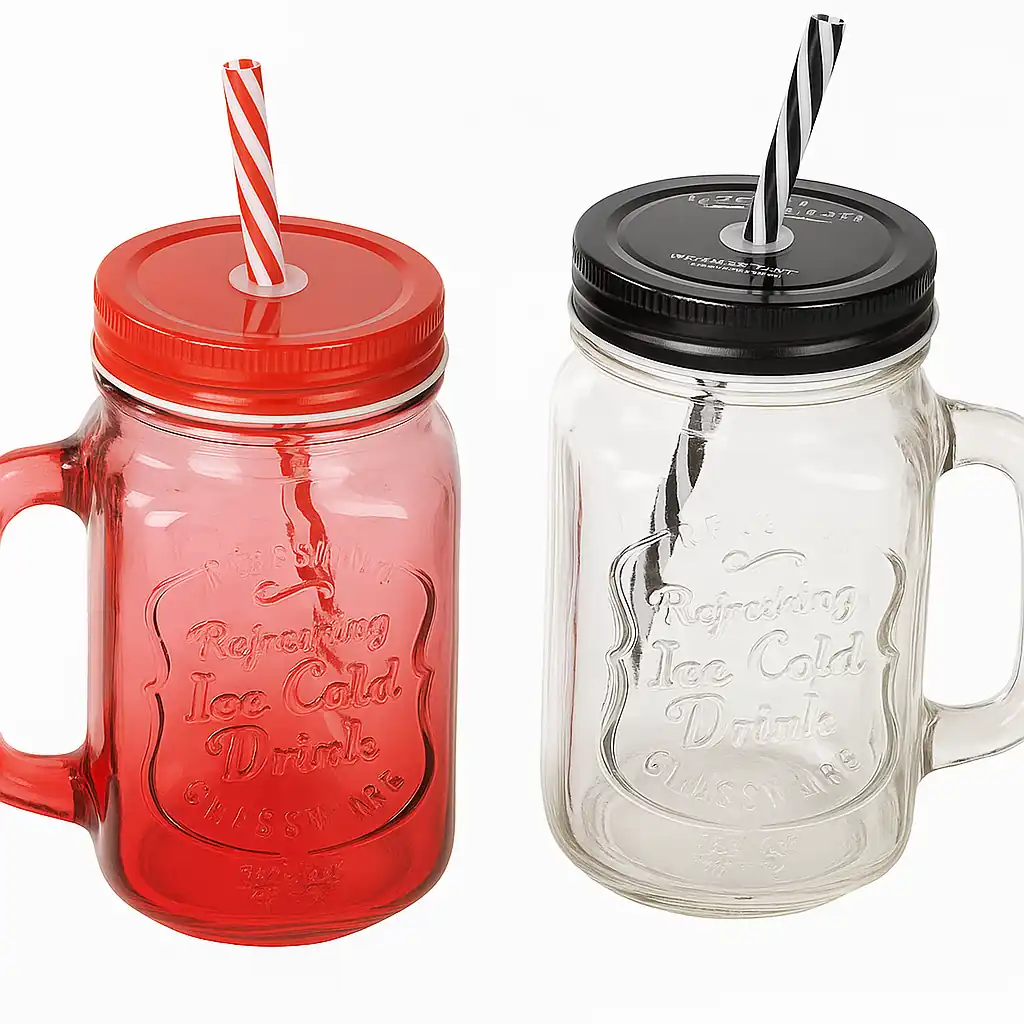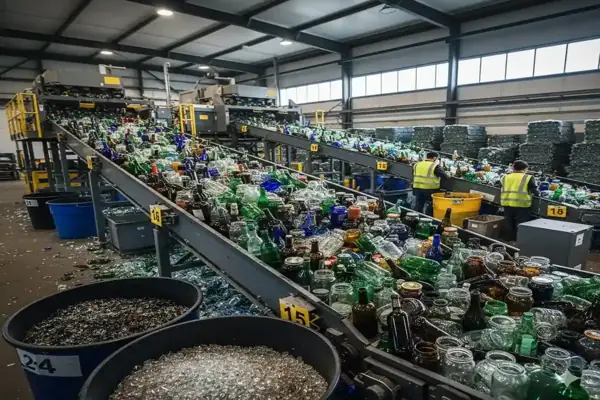From supermarket shelves to luxury food brands, glass jars are everywhere. But how are they really made, and what makes some better than others? The answer lies in the science, precision, and craftsmanship behind every production line.
Glass jars are made through a multi‑step process involving raw material preparation, melting at high temperatures, forming with precision molds, annealing for strength, and rigorous quality control. This ensures each jar is safe, durable, and ready for branding or export.

Whether you’re sourcing from a new glass jar supplier or planning your next private‑label launch, understanding how glass jars are made helps you make better, faster procurement decisions. Let’s walk through the entire journey from sand to shelf — and see why more global brands are choosing modern glass factories over outdated suppliers (see sourcing tips at Slyprc.com 6{#ref-6}).
What Are Glass Jars Made Of? Essential Raw Materials Explained
Behind every clear, smooth jar is a precise mix of earth‑derived materials. But not all raw materials are created equal — and poor inputs mean weak or yellowing glass.
Glass jars are primarily made of arena silícea, soda ash, limestone, and cullet (recycled glass). These ingredients are combined in exact ratios to achieve clarity, strength, and food safety (for example, the common composition of soda–lime glass is ~70–75% SiO₂, ~12–16% Na₂O, ~5–10% CaO).1{#ref-1}
Understanding the Core Ingredients
| Raw Material | Role in Glass Formation | Quality Impact |
|---|---|---|
| Silica Sand | Main glass‑forming ingredient | Clarity and durability |
| Soda Ash | Disminuye el punto de fusión | Improves energy efficiency |
| Limestone | Stabilizes the mix | Enhances chemical durability |
| Cullet (Recycled Glass) | Reduces energy use and cost | Sustainability, faster melt |
Why Raw Material Quality Matters
I once sourced from a supplier that used unwashed sand — it led to bubbles and discoloration. Since then, I’ve worked only with factories that use washed, high‑purity silica and pre‑treated cullet. This is critical for large‑volume production for B2B clients across multiple regions.
In modern factories, raw materials are batched with digital precision, stored in silos, and fed automatically into the melting furnace. This automation cuts errors and ensures every batch meets compliance standards like FDA, LFGB o DGCCRF — something essential for international buyers.
I recommend buyers always ask for supplier documentation on raw material sources, especially cullet origin and silica purity.
How Does the Glass Melting Process Work in Factories?
Transforming raw materials into molten glass requires intense heat and exact timing. A small deviation can cause defects in strength, shape, or transparency.
In modern factories, glass is melted at ~1,500 °C in continuous furnaces (regenerative or oxy‑fuel‑boosted) to deliver a uniform, bubble‑free liquid ready for forming.8{#ref-8}
Melting Technology in Modern Production
| Furnace Type | Descripción | Ventaja |
|---|---|---|
| Regenerative Furnace | Uses heat exchangers to recycle energy | Lower energy cost, eco‑friendly |
| Electric Boosted | Adds electrodes for faster melting | Better control, fewer emissions |
| Oxy‑Fuel Furnace | Burns pure oxygen, not air | High efficiency, reduced NOₓ gases |
How Factories Maintain Uniform Glass Quality
The key is stability. At our facility we maintain ±5 °C precision around the 1,500 °C set‑point. This stability ensures uniform flow into the fore‑hearth, avoiding uneven thickness or internal stress. Each batch’s viscosity is monitored in real time using viscosity probes.
I recommend importers verify furnace type and temperature‑control specs during the factory audit — it’s often the root cause behind hazy glass or bubbles.
Press‑and‑Blow vs. Blow‑and‑Blow: Which Is Better for Glass Jars?
The shape and thickness of a jar don’t just depend on the mold — the forming method matters too.
Press‑and‑blow is better for wide‑mouth jars needing precise wall thickness, whereas blow‑and‑blow is more often used for narrow‑neck containers like bottles.2{#ref-2}
Comparing Forming Techniques
| Método | Lo mejor para | Process Summary | Pros |
|---|---|---|---|
| Press‑and‑Blow | Wide‑mouth jars | Molten gob pressed into a blank mold, then blown into final shape | Consistent wall thickness |
| Blow‑and‑Blow | Bottles, narrow jars | Gob blown into blank, then final mold | Cost‑effective for bottles |
Why Press‑and‑Blow Is My Preferred Choice
One European client selling organic sauces had a 7% leakage rate with blow‑and‑blow jars due to uneven rims. We switched them to press‑and‑blow, and the defect rate dropped to below 1.2% within two months. The plunger method gave better rim control and improved sealing.
For B2B buyers, I recommend selecting press‑and‑blow for wide‑mouth packaging — especially if your cap system depends on precise neck tolerance.
Why Annealing Is Critical in Glass Jar Manufacturing
Glass jars may cool fast, but if cooled unevenly, they can shatter under minor stress. That’s where recocido comes in.
Annealing slowly cools glass jars in a lehr oven to relieve internal stress, preventing cracks and improving impact resistance.3{#ref-3}
Annealing Process Step‑by‑Step
| Paso | Descripción | Impact on Quality |
|---|---|---|
| Hot End Entry | Jar enters at ~600 °C | Prepares for uniform cooling |
| Soaking Zone | Maintains even temperature | Relieves internal stress |
| Cooling Zone | Gradually drops to room temperature | Prevents thermal shock |
What Happens Without Proper Annealing?
Our annealing lines are 18 metres long and segmented into 3 zones. We track thermal curves via embedded sensors in each segment. Any anomaly automatically flags a QC check.
I strongly recommend verifying whether the supplier uses programmable lehrs and how they validate stress removal — ask for a stress‑inspection report if available.
How Quality Control Ensures Every Glass Jar Meets Global Standards
Even small defects can cause big problems in B2B supply chains: a bubble near the rim, a hairline crack, or the wrong mouth size can cause recalls, brand damage or regulatory issues.
Modern glass factories implement multi‑step quality control — combining visual inspection, automated sensors, and random sampling — to ensure every jar meets global compliance standards (including [FDA], [LFGB], [DGCCRF]).

Typical Quality Control Process
| Paso de control de calidad | What It Detects | Tools Used |
|---|---|---|
| Hot End Inspection | Shape, wall thickness, gob defects | Infra‑red sensors, weight scales |
| Cold End Inspection | Bubbles, cracks, surface issues | High‑speed cameras, laser detectors |
| Sampling + Lab Tests | Drop impact, leakage, chemical safety | Autoclaves, FTIR, impact testers |
Quality Data from Our Line
At our facility, production lines include 100% cold‑end camera inspection and random manual checks every 45 minutes. Each batch has traceable QA reports. Our lab runs daily ASTM drop‑tests and autoclave cycles.
I recommend buyers request to review actual QC records during factory audits — including rejection‑rate logs and lab reports for recent lots.
How We Help Buyers Solve Common Production Challenges
In the past 3 years we’ve supported over 20 international buyers to reduce return‑rates and delays by addressing three common pain‑points:
- Breakage during shipping — We redesigned internal packaging and moved to pallet‑based logistics with foam corner guards, reducing breakage by 60%.
- Packaging performance — We tested seal integrity under high‑heat, vacuum, freezer conditions, ensuring compatibility with client lids.
- Rush orders — For seasonal clients we developed a fast‑track protocol with 7‑day lead time and dedicated QC teams — no quality compromise.
If you’re a category manager or sourcing director, we’re not just a glass jar factory — we’re your launch‑team partner.
Glass Jar Decoration Techniques: Printing, Coating, and Labelling Explained
A good jar protects the product. A great jar sells it. Decoration is key to visual appeal, shelf presence and brand storytelling.
Glass jars can be decorated with [screen‑printing], acid‑etching, [UV‑coating] or pressure‑sensitive labelling — each suited to unique market segments. (For more on ink‑migration limits check food‑contact regulation.)4{#ref-4}

Common Decoration Methods
| Método | Look & Feel | Durabilidad | Best For |
|---|---|---|---|
| Screen‑Printing | Raised ink, bold colours | Alta | Premium or minimalist brands |
| Acid‑Etching | Frosted, matte surface | Medio | Natural, eco‑themed products |
| UV‑Coating | Glossy or metallic finish | Medium‑High | Luxury goods |
| Pressure‑Sensitive Labelling | Custom graphics, cost‑efficient | Medio | Mass‑market, seasonal items |
Buyers should confirm whether decorative processes meet ink‑migration limits (e.g., EU 10/2011) for food‑contact packaging.
How Modern Glass Jar Factories Achieve Sustainability and Recycling Efficiency
Eco‑conscious consumers expect more than reusable packaging — they expect transparency in the supply chain.
Modern glass factories recycle cullet, implement energy‑efficient furnaces, and adopt closed‑loop water‑systems for minimum environmental footprint. Check global recycling stats at the Glass Packaging Institute.9{#ref-9}

Green Practices in Glass Production
| Initiative | Descripción | Beneficio medioambiental |
|---|---|---|
| Cullet Usage | Recycled glass replaces virgin raw materials | Lowers energy consumption, CO₂ |
| Heat Recovery | Uses exhaust heat to pre‑heat materials | Reduces fuel use |
| Water Recycling | Filters & reuses cooling water | Minimizes freshwater usage |
Our Sustainability Metrics
In 2024, 33% of our raw‑material batch was cullet. We reduced CO₂ emissions by 14% year‑over‑year. Our wastewater‑recycling loop returned 96% of process water to reuse.
I recommend buyers ask suppliers for recent energy use and recycling data — not just claims. Look for ISO 14001 certification too.5{#ref-5}
Why Global Brands Choose Us as Their Trusted Glass Jar Manufacturer
There are thousands of jar factories — but few who deliver consistent quality, reliable service and global‑scale logistics.
Global brands choose us because we offer full‑certifications, design support, low breakage rates, on‑time delivery and dedicated OEM/ODM service. (See sourcing platform insights at Slyprc.com for factory comparisons).6{#ref-6}

Why We Stand Out
| Característica | Our Advantage |
|---|---|
| Certificaciones | FDA, LFGB, DGCCRF, Walmart, BSCI |
| Control de calidad | 100% hot‑end + cold‑end inspection |
| Design Support | OEM/ODM, custom molds, decoration flexibility |
| Logística | Palletised packaging, low breakage |
| Sostenibilidad | High cullet usage, ISO 14001 certified, low emissions |
If you’re choosing a supplier for long‑term partnership, always validate their real delivery performance, customisation flexibility and post‑shipment support.
Conclusión
Modern glass jar manufacturing is both an art and a science. From sourcing clean raw materials, forming with precision, to controlling every quality metric, the process ensures each jar is safe, sustainable and shelf‑ready. Whether you’re a retailer, importer or brand developer, knowing how glass jars are made helps you choose the right partner — and our commitment to quality, design and sustainability positions us as that partner.
Notas a pie de página
1. Composition data of soda–lime glass — the most common container‑glass type. ↩︎
2. Comparison of [press‑and‑blow vs blow‑and‑blow] methods for container glass. ↩︎
3. Reference on the recocido process and its role in relieving internal stress. ↩︎
4. Source for ink‑migration and surface‑decoration compliance in food‑contact packaging. ↩︎
5. Report on circular economy, cullet usage and sustainability in glass container production. ↩︎
6. Guidelines for sourcing reliable OEM/ODM glass‑jar manufacturers via [Slyprc.com]. ↩︎
8. Analysis of container‑glass forming and energy‑efficient furnace types. ↩︎
9. Facts on glass recycling and benefits from [Glass Packaging Institute]. ↩︎
